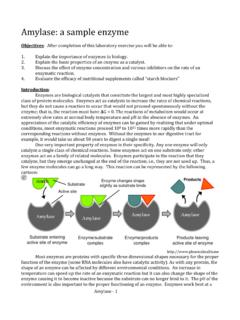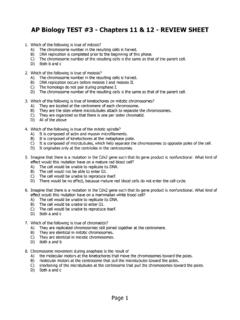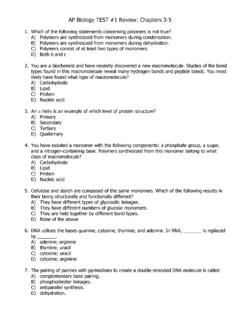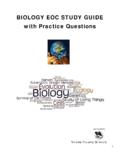Transcription of Chapter 3: Molecular Biology Problems
1 Chapter 3: Molecular Biology Problems 166 Classic DNA Experiments Molecular Biology Problems If you were a Molecular biologist, you would focus on biological molecules like DNA, RNA, and proteins. Although generally true, your work would overlap with other areas like genetics and biochemistry. In this Chapter , we have given you Problems that will allow you to explore the structure and function of DNA and RNA and how proteins are elaborated in the cell. The first Problems examine some of the most important experiments that led to the conclusion that DNA is the genetic material. They are good examples of the history of science as well as opportunities to analyze real data. Before attempting the question in this section, refer to your textbook or lecture material. The first diagnostic question for this Chapter is found in section 2. Work through the diagnostic question on your own and then look at our approach to solving it.
2 If any of the terms are unfamiliar, consult the appropriate Chapter in your textbook. (1) Problems EXPLORING CLASSIC EXPERIMENTS Key words: Griffith, Streptococcus pneumoniae, Transforming Principle, Avery, Pneumococcus, Hershey, and Chase. Note that this section does not have a diagnostic problem ; you should consult your textbook for further information if you have difficulty working these Problems . ( ) Frederick Griffith showed that a component of dead bacterial cells could confer new properties to live bacteria of the same species. The property in question was the presence of a surface polysaccharide capsule of the bacterium Streptococcus pneumoniae, the bacterium that causes pneumonia. Two types of these bacteria are found, based on two main types of surface polysaccharide: 1) R (rough) cells have no polysaccharide capsule. These bacteria do not cause disease. They are nonvirulent. 2) S (smooth) cells have a polysaccharide capsule.
3 These bacteria cause disease and are virulent. The S (smooth) cells fall into several different subtypes based upon the polysaccharide capsule. These are designated SI through SXXIII. You can isolate mutants of all these S strains that no longer make a capsule and are no longer virulent. The lack of a polysaccharide capsule makes one R strain indistinguishable from another. However, R strains are also designated R(I) through R(XXIII), depending upon their origin. An R strain derived from SIII is designated R(III). Chapter 3: Molecular Biology Problems The central experiment was: Experiment: Inject a mixture of R(II) and heat-killed SIII into a mouse. Results: The mouse dies of pneumonia, and virulent SIII bacteria can be isolated from the mouse. Griffith et al. also did some control experiments to support experiment 1. Negative Control: Inject R(II) or heat-killed SIII alone into a mouse. Results: The mouse lives. Positive Control: Inject live SIII alone into a mouse.
4 Results: The mouse dies of pneumonia, and only virulent SIII bacteria can be isolated from the mouse. a) For each of the control experiments listed, explain: What alternative models does the result of this control experiment rule out? That is, complete the sentence, Without this control result, you could argue that the mice died in experiment 1 What would it have meant for their model if the results of this control experiment were the reverse of those expected (the mouse dies instead of living and vice versa), assuming that the results of experiment 1 were the same as above? b) Another potential problem with their experiments was the possibility that, at a low frequency, R(II) can mutate back to the SII from which it was derived. (Note: R(II) cannot revert to any other subtype of S.) Based on this, why was it essential that they use a mixture of R(II) and heat-killed SIII instead of a mixture of R(II) and heat-killed SII?
5 Classic DNA Experiments ( ) The team of Avery, McCarty, and MacLeod was attempting to purify a substance from smooth (S) pneumococci which was capable of transforming rough (R) pneumococci into smooth; they called this substance the transforming substance. a) They presumed that the transforming substance was genetic material ( genes). Explain why they believed that this was so. The authors were trying to distinguish between two models for the transforming substance (genes): (1) Genes are made of protein. (2) Genes are made of DNA. It was their belief that model (2) was correct. They wanted to purify the transforming substance away from other cellular material and then determine whether it was pure DNA or a mixture of protein and DNA. They hoped to show that protein was either not present or not essential for the transforming substance to be able to transform R to S. b) If they had found traces of protein in their preparations of the transforming substance (even if it was >99% DNA), this would have made it impossible to rule out model (1).
6 Explain why this is so. c) In their paper, they presented an analysis of the elemental composition of several of their purified preparations. In particular, they compared the ratio of nitrogen to phosphorus (N/P ratio) of their preparations, with the N/P ratio predicted based on the structure of DNA. i) Using the structure of DNA from your text, the atomic weight of N = 15 and the atomic weight of P = 31, show that the ratio for the DNA: total mass of Ntotal mass of P = ii) If their preparations were contaminated with protein, would you expect the ratio of the preparations to be higher or lower than Explain your reasoning. Chapter 3: Molecular Biology Problems These are their actual data (all of these preparations could transform R to S): Preparation # N/P ratio 37 38B 42 44 iii) What conclusions would you draw from these data, and what would be your reservations about these conclusions? d) In another series of experiments, preparations were treated with various enzymes of known function.
7 They wanted to determine whether these enzymes were capable of destroying the transforming ability of the preparations. They treated their preparations with the following enzymes alone or in combination: Trypsin: an enzyme that breaks proteins down into amino acids. Chymotrypsin: another enzyme that breaks proteins down into amino acids. None of these treatments had any effect on the transforming ability of their preparations. i) Why do these data support model (2)? ii) Why are these data, on their own, not completely conclusive? If you believed in model (1), how would you argue that these data are consistent with model (1)? ( ) Hershey and Chase provided strong evidence that DNA, and not protein, is the genetic coding material of the cell through their experiments involving differential partitioning of 32P-labeled DNA and 35S-labeled protein of bacteriophage T2. a) In their studies, there were two crucial experiments.
8 Experiment 1: Bacteriophage were labeled with 32P, which is incorporated only into DNA. Experiment 2: Bacteriophage were labeled with 35S, which is incorporated only into protein. Classic DNA Experiments The bacteriophage were allowed to attach to the bacterial cells and transmit the genetic material. The bacteria and the bacteriophage were then separated, and the amount of radioisotope in each was measured. For each scenario below, describe how much radioactivity you would expect to find in the phage as opposed to the bacteria (for example: a lot, some of it, little, or none). Explain your reasoning briefly. i) If the phage contained both DNA and protein but the genetic material injected was protein and the DNA remains in the phage head. ii) If the genetic material were a mixture of mostly DNA and a little protein. iii) If the genetic material were protein that is carried on the DNA and the DNA is only a scaffold for carrying the protein genetic material.
9 B) Actually, the data were not as unambiguous as described in most textbooks. (For an interesting discussion of how this experiment has changed in the telling and retelling, see How history has blended, Nature 249:803-805, 1974.) They performed the experiment several times and got the following results: (1) Between 15% and 35% of the32P was found in the supernatant. (2) Between 18% and 25% of the 35S was found in the pellet. Assume that their model is correct (the phage injects DNA and not protein). i) What could have caused the presence of the 32P in the supernatant? How crucial for their model is it that this number be 0? Why? ii) What could have caused the presence of some of the 35S in the pellet? How crucial for their model is it that this number be 0%? Why? Chapter 3: Molecular Biology Problems c) Based on the above data, which of the models (i, ii, or iii) in part (a) can you rule out? Explain your reasoning.
10 ( ) On a mission to a new solar system, you discover an alien virus that contains nucleic acids, proteins, and lipids. You also find that this virus can infect E. coli cells, making it easy to study in the laboratory. a) You grow this virus with one of the following radioisotopes: 32P, 3H, or 35S. Which of the viral macromolecules will be labeled with 32P? Which of the viral macromolecules will be labeled with 3H? Which of the viral macromolecules will be labeled with 35S? b) You analyze the nucleic acid and find the following: Percentage of each base: A G T C U What nucleic acid is the virus carrying? How do you know this? c) Because this is an alien virus, you want to determine which of the macromolecules (nucleic acids, proteins, and lipids) is the hereditary material. Explain how you would do this. Classic DNA Experiments d) You examine DNA replication to determine whether it is similar to DNA replication on Earth.










